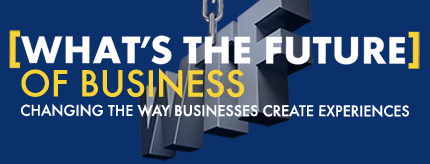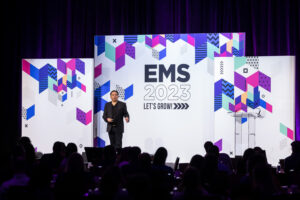Customer experience is meant to be evocative not reactive…
We are entering an era of customer-centricity, mostly because we have to. But also, because employing a customer focus is the right thing to do. I guess businesses lost their way at some point. Blame quarterly earnings. Blame technology. Blame politics. But over the years, we overlooked the importance of the “C” and “R” and instead scaled the “M” in CRM. It didn’t hurt that we found ways to save time and money in the process of promoting management, cost-control and efficiency over customer experiences.
I don’t believe executives aim to deliver substandard experiences. I really don’t. In fact, 88% of all businesses actually believe that they deliver great customer service. Yet only 8% of their customers agree. Saying that there’s a disconnect is an understatement at best. But it is representative of a significant experience gap that exists between the experience we promise and the experiences people have and share.
A large part of the problem is how we see the role and value of customer engagement in overall business. Anyone working in the game knows all too well that investing in customer retention is a far more cost-effective strategy than that of customer acquisition. Yes both are important. But by reducing anything related to the experience of existing customers, you’re essentially pushing them out and relying on customer growth programs to find people to constantly take the place of deserters. It’s a revolving door where you only win if more people come in than leave. Who wants to do business that way?
Intelligent speech processing technology company Nuance Communications commissioned a survey of 1,000 American consumers to reveal current perceptions about customer service departments. The study found that nine out of ten consumers report that a company’s customer service has a significant impact on their decision to do business with them. More so, the majority of American consumers (74 percent) did not rate the customer service they’ve received in the last twelve months an “A” grade.
On the other hand, many consumers also said that they respond positively if they receive good customer service. In the Nuance study, 80 percent of consumers say they’ve taken action following a good experience. For example, more than one-third said they have recommended the company to friends and family or conducted more business with that company (34 percent).
If excellent customer engagement works, then why is it that I have to take the time to write this article? And, I’m not the only one bringing this up either.
The answer is that customer service and support are functions that are still viewed and run as cost-centers and not as strategic investments in customer experiences. This is a shame because study after study shows that a wonderful customer experience boosts customer loyalty and advocacy and establishes a tremendous competitive advantage.
Speaking of cost centers…
The 80s Called, They Want The Contact Center Back
Just look at the call center as one example of just how far we got away from prioritizing meaningful and delightful customer experiences. It should hurt. It should cause duress. It shouldn’t force people away from us.
If you’re like me and if I’m like you, we dread calling any company. We know that we’re going to have to lose our minds pressing buttons until we get a human being on the line. We know going in that we’ll completely suffer from a complete loss of sanity from having to re-explain ourselves over and over as we are transferred between departments.
It shouldn’t to be this way, but it is unfortunately. In most cases, we have no choice. We need to accomplish things and by calling, we’re committing to getting an answer or mission achieved in the moment.
The problem is that though customer experiences are paramount, investing in and measuring their success is elusive or under appreciated or both. Businesses tend to favor quantity of customer engagements over quality and also expediency over experience.
The call center is in need of a renaissance in both purpose and focus. To do so, executive teams also need to undergo a renaissance to move from management to that of leadership. And, that starts with vision and puspose.
With roots traced to the late 1950s to 1960s, call centers were initially designed to scale outbound and inbound calls. As time went on, new technologies and behavioral engagement strategies enabled call centers to handle greater volume and responsibilities. Suddenly call centers were the go to model for facilitating all forms of mass engagement ranging from sales to customer service and support to customer retention. As time went on and capabilities expanded, soaring costs and management challenges ultimately made the case for many businesses to contract outsourced call center solutions. To save money and also to ramp up resources quickly, some of the largest outsourced facilities resided outside of the United State in countries where English was a second language at best.
Why the rapid-fire history lesson on call centers?
For the most part, call centers served their purpose over the decades. Everything was fine until it wasn’t. That time to change is here. Actually, it’s overdue. What the call center was designed to do and how it was both valued and also measured for success are part of an eroding mode of business that has no place in the future of customer experience.
The great irony here however are the words customer service or customer support. Clearly, we are missing opportunities to provide service or support in ways people value. Actually contacting customer support almost seems like a last resort. In fact, customers are taking it upon themselves to find answers online with 82% of consumers agreeing that they only contact customer service when they can’t find an answer online according to Nuance. It’s often just easier or more pleasant that having to talk to the a company’s customer support front line.
We hate them. We need them. But with purpose, renovation and some serious unlearning, these existing assets can be rebuilt and retrained to deliver exception customer experiences, cultivate relationships and drive business value.
Customers have repeatedly expressed that they will gladly pay a premium for products if they believed that a premium customer experience was a given. It’s sad but true that customer experience can become a competitive advantage rather than a commodity, but so be it.
Customer support, service, and form of customer engagement really, are clearly ripe for disruption and innovation. Price, process, technology, et al., further distanced us from customers. But the same set of ingredients can bring us closer than ever before.
Call centers are on the front line right now. They can do better. But we need to first accept that the role they play today is not actually shaping customer experiences but hindering or degrading them.
Experience takes vision and it takes architecture.
Imagine if technology, process, systems, metrics, were driven by a higher purpose?
Sales, service, support, loyalty, every facet of the customer journey and lifecycle, could and would be improved. Customer-centricity would truly form the center of our intentions and work. Then and only then, would meaningful relationships become a byproduct of the experiences we set out to create and cultivate.
What a wonderful world it would be…
Connect with me… Twitter | LinkedIn | Facebook | Youtube | Instagram | Pinterest
Angry Customer Picture: Shutterstock







@Brian – all insightful and valid from a grand and theoretical perspective.
But recently, in a moment of clarity while ruminating and still bruised from a particularly obstructive and infuriating experience with a “customer service” call center, I realized why all the attempts at efficiency and process improvement yield no improvement.
The people in charge; those who consistently proclaim the sanctity of that service, never use the system. They have direct dials and cell phones by which to reach their staff for answers. They have PAs that can navigate even internal bureaucracies to help them resolve challenges. In other words, their sense of customer experience is the assurance from a manager, whose own experience is a flow chart, that it will ease the customer experience.
That and the fact that there’s no competitive pressure to improve. Just last night I felt my blood pressure rise as I listened to my wife spend two hours trying, unsuccessfully, to reschedule a package delivery by one of the major small parcel carriers (and prime competitor to the company with which I had my recent experience.) Amazingly they couldn’t even figure out how to accept her $5 payment and therefore agreed to a resolution that they’ll attempt delivery three times, knowing it will fail, so that the package can then be held at a center for her to pick up. It’s efficient….until it’s not efficient.
So any exec who wants to revolutionize this experience will earn themselves a spot in the pantheon of business greats. But if they don’t set out to build a system which they will personally use for every internal communication as well, they’re building it to a standard which will merely perpetuate the failed systems we already have.
But call centers and poor “customer service” are a metaphor for other customer interactions too – both post purchase and pre purchase. My recent experience and moment of clarity also prompted a realization that the same detached perspective is behind much of the digital marketing mediocrity one sees today. When one can quickly find what’s needed in Sharepoint, then the importance of intuitive navigation and resources on a customer facing website is less important. Similarly when one envisions a design and content based on company organization and priorities, and reviews the experience starting from a ‘home page’ and knowing the navigational architecture….then goes away never using it again….you get web interactions that mirror the call center train wreck. That’s why I wrote this. http://www.consiliumglobalbusinessadvisors.com/stages-of-business-development-for-b2b-manufacturers/one-question-tells-whether-your-market-development-strategy-will-work
The difference? Nobody does you the favor of yelling at you for you to capture experience metrics. They just move to a competitor; and move again; and again until they find a company that understands their problems.
It’s not a call center challenge, and it’s not even a “customer service” issue. It’s a fundamental business management failure – and an incredible opportunity for companies that take your advice, apply vision and architecture, and make the world a better place.
Very well said and very true. This is a post unto itself and I’m sending the link out for people to enjoy.
Great post Brian. The reality is that in 2015, brands have not yet grasped the notion of an integrated experience across all channels including sales, service and marketing. Technology, when properly leveraged and under the leadership of the right people, can bridge that gap. The key is building an ecosystem where organizations across all departments have access to a singular view of the customer at every point they engage with the brand. Building out this architecture ensures that these organizations are in a position to understand their customers on a deeper level and anticipate their needs moving forward.
Thank you for the comment. Cheers!
There is a growing backlash against outbound call centres in the UK right now, and having worked in an outbound-based business for some years, the pressure to reach targets results in staff just not caring who they call, how many times etc. Contact centres have their place but you’re right, it’s lost and overdue for fixing.
Great comment Kate. Let’s do something about it! 🙂
First port of call may be investors – when a business strategy needs to take a paradigm shift like this, VCs are staring into the unknown and may prefer to bleed the dinosaur. Call centres could learn a lot from local print which has passed the ‘change or die’ threshold.
Amen Kate.
Brian –
Great article. I agree the customer experience is paramount to building
brand loyalty and customer retention. In today’s digital era, consumers
have more access to information and more choices than ever before, so if
we want to build and maintain loyal, satisfied customers, we have to make
it easy for them to do business with us. Conceptually, most CIOs and
business decision-makers understand this and know that customer
satisfaction is critical to business success. Yet many don’t consider how
inefficient business processes impact the overall customer experience.
Take the customer contact center, for example. If we know this is a
customer pain point, then we should focus on integrating our business
processes across departments so that customers don’t need to continually
repeat the same information. However, as organizations have taken initial
runs at digitizing and streamlining business processes in silos, capturing
this information might involve any number of back-end systems, leading to
a disjointed and time-consuming process, and a more challenging customer
experience instead.
-Andy Jones, Xerox
Well said Andy. Thank you.